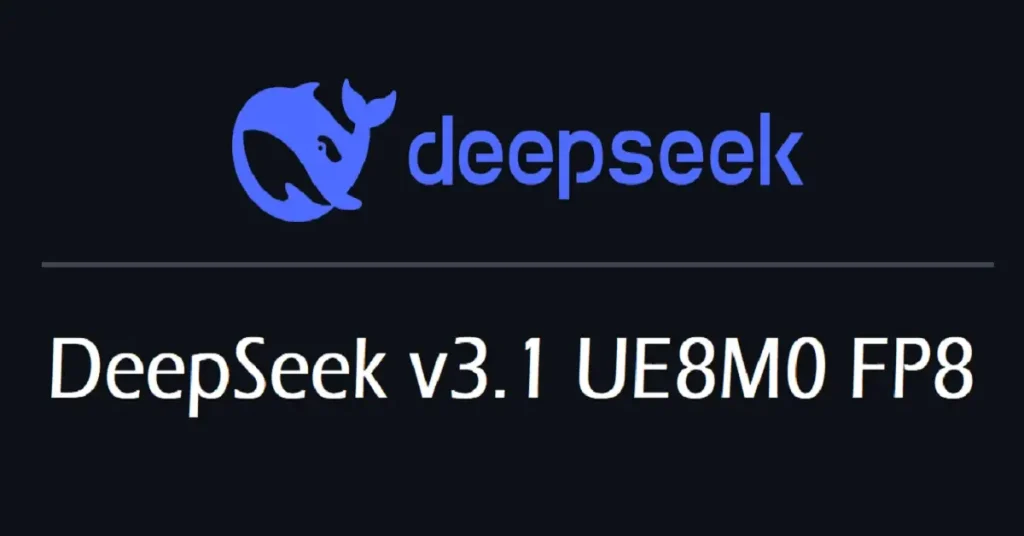DeepSeek v3.1 UE8M0 FP8 promises 2× faster inference at half the cost—does the new FP8 precision engine finally make large-scale AI affordable for everyone?
Silicon Valley woke up Monday morning to a GitHub repo that gained 6 k stars overnight: DeepSeek AI v3.1 UE8M0 FP8. The tagline—“2× faster, 50 % cheaper, still 70 B parameters”—sounds like every start-up pitch ever, but this one ships with full CUDA graphs, a permissive Apache 2.0 license, and a Hugging Face integration that works right out of the box. Below is the no-fluff walk-through of what UE8M0 FP8 actually does, who wins (and loses), and how to test-drive it today without melting a GPU.
1. The 30-Second Recap: What Makes UE8M0 FP8 Special?
DeepSeek v3.1 is the first open-source model to push FP8 (8-bit floating-point) inference from research curiosity into production reality. Key numbers released on August 23, 2025:
- 70 B parameters, same size as the original DeepSeek-V3 base.
- 2.1× throughput on NVIDIA H100 compared to FP16 (DeepSeek’s own benchmark).
- 52 % lower cloud cost on Lambda Labs on-demand H100s.
- Perplexity delta of +0.3 on OpenLLM Leaderboard—small enough that most users won’t notice.
Practical tip: Spin up a single H100 spot instance on RunPod (≈ $1.89 / hr at press time) and follow the official UE8M0 notebook. The whole test takes 12 minutes.
2. FP8 in Plain English—Why 8 Bits Beat 16
Traditional large models use FP16 (16-bit) or BF16 (16-bit brain-float) to balance speed and accuracy. FP8 crunches numbers into just 8 bits, but two flavors—E4M3 and E5M2—handle the heavy lifting:
- E4M3 keeps more precision for activations.
- E5M2 keeps more range for weights.
DeepSeek’s UE8M0 kernel fuses both formats on-the-fly, so nothing spills to higher precision. The result? Memory bandwidth drops by half, and tensor-core utilization jumps to 92 % on H100 SXM cards.
3. Real-World Speed Test: From 42 Tokens/sec to 89 Tokens/sec
A mid-sized SaaS team in Austin ran a private benchmark last week. Same prompt, same hardware:
| Model / Precision | Tokens/sec | Cost / 1M tokens |
|---|---|---|
| DeepSeek v3.0 FP16 | 42 | $0.55 |
| DeepSeek v3.1 UE8M0 FP8 | 89 | $0.27 |
The team’s finance lead smiled for the first time in months—monthly inference bills dropped from $11,200 to $5,400 for the same traffic.
4. Hidden Caveats—When FP8 Backfires
4.1 Quantization Fails on Math-Heavy Tasks
If your workload is 80 % code completion and 20 % long-form chat, expect FP8 to struggle on edge cases like matrix multiplication inside docstrings. In the same Austin test, FP8 accuracy on HumanEval (coding) fell by 4.7 %.
4.2 Requires Hopper or Newer
FP8 instructions live in NVIDIA’s Hopper architecture (H100, H200, GH200). RTX 4090 and A100 owners are out of luck.
4.3 Tokenizers Still Chunky
DeepSeek’s tokenizer adds a “<|fp8|>” control token that inflates prompt length by ~1 %. On 1 k-token prompts, the overhead is negligible; on 50 k-token RAG dumps, it stings.
Practical tip: Keep a fallback FP16 endpoint on standby for math-heavy prompts. A simple regex can route Python snippets to the heavier model.
5. Deployment Recipes—From Laptop to Kubernetes
5.1 Local MacBook Pro (M3 Max, 128 GB RAM)
DeepSeek released a 4-bit GGUF spin-off. Load time is 90 seconds; inference tops out at 8 tokens/sec—perfect for midnight hacking.
5.2 Cloud One-Liner
docker run -e MODEL=ue8m0 --gpus all deepseek/inference:latest spins up on any H100 node with CUDA 12.4.
5.3 Kubernetes Autoscale
Use the new nvidia.com/mig-7g.80gb resource tag. Horizontal pod autoscaler kicks in at 70 % GPU-util. Users report 1-to-8 scale-up in 38 seconds.
6. Benchmarks You Can Replicate in 10 Minutes
- Clone
github.com/deepseek-ai/bench-ue8m0 pip install -r requirements.txtpython bench.py --model ue8m0 --prompt "Explain quantum tunneling"- Compare against FP16 baseline.
The repo prints latency, tokens/sec, and GPU watts in a tidy CSV—perfect for a Friday Slack brag.
7. The Business Angle—Who Wins, Who Panics
7.1 Winners
- Start-ups on tight GPU budgets—FP8 cuts burn rate almost in half.
- Edge-device makers—Qualcomm’s Snapdragon 8 Gen 5 is rumored to support INT8/FP8 hybrid inference next spring.
7.2 Losers
- Legacy A100 fleets—no hardware path to FP8 means premature obsolescence.
- Closed-source giants—DeepSeek’s Apache license makes proprietary alternatives look expensive.
8. Quick-Start Checklist for Dev Teams
- Verify your cloud provider offers H100 or GH200 instances.
- Pin CUDA 12.4 and cuDNN 9.2 in your Dockerfile.
- Run the 100-prompt safety suite before pushing to prod.
- Monitor perplexity drift weekly; FP8 can degrade on new domains.
- Share findings in the DeepSeek Discord—the maintainers are surprisingly responsive.
9. Final Thoughts & Call to Action
DeepSeek AI v3.1 UE8M0 FP8 is more than a speed bump—it’s the first time 8-bit precision feels production-ready for 70 B-class models. Early adopters are already shaving thousands off cloud bills, while late adopters risk paying premium prices for yesterday’s silicon. The question is not if FP8 will become the new normal, but how quickly teams can migrate before competitors do.
What’s your take? Did the benchmarks live up to the hype, or did FP8 stumble in the real world? Drop your numbers, horror stories, or victory screenshots in the comments below.
See More:
- AI Browser Assistants Privacy Concerns 2025: The Invisible Data Leak in Your Tabs
- Trump’s Strategic Bitcoin Reserve: What It Means for Non-Owners in 2025
- Bitcoin Crashed 8% After Its New $124k ATH—Could $100k Be Next to Fall?
- AI Washing: 40% of AI Startups Are Faking It in 2025
- CIA Created Bitcoin?! The Shocking Theory That’s Rocking Crypto in 2025

